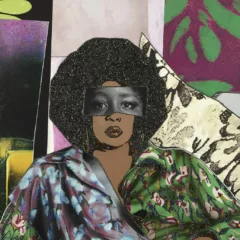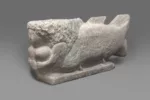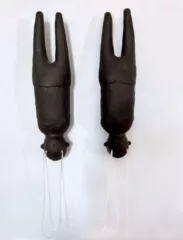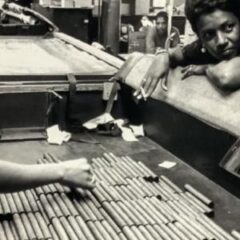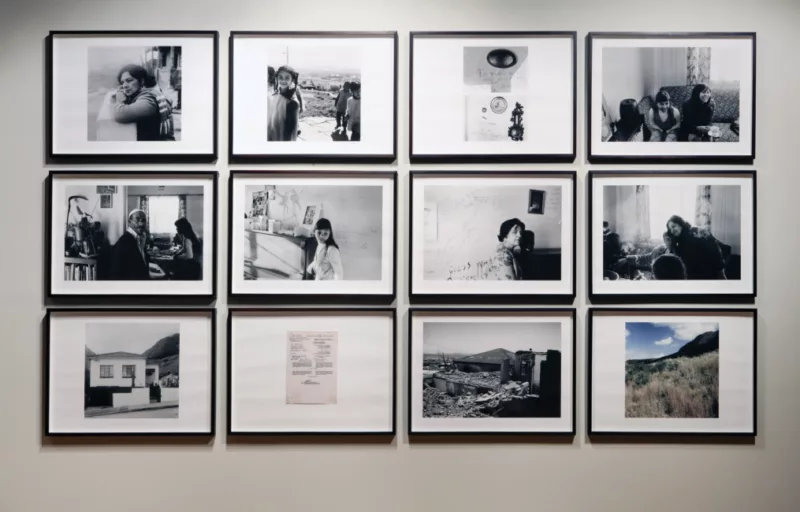
This exhibit is a curated conversation of the artwork of Sue Williamson and Lebohang Kganye – two women standing within different generations of South African artists. Williamson is more than twice Kganye’s age and she began her artistic practice in the 1970s during the apartheid in South Africa. Kganye is a member of what is called the “born free” generation; she began making artwork after South Africa had a democratic government for 20 years. This exhibit is all about intergenerational memory and cultural inheritance. It asks questions about the function, meaning, and structure of memory, storytelling, and forgiveness.
The Apartheid in South Africa created a severely stratified society of rigid racial segregation and was in effect from 1948 to 1994. White governments and political groups leveraged laws, power, wealth, and both state and civilian violence to instate and enforce this separation based on race. The minority White population received the highest privilege and status, while Black South Africans were relegated to the lowest strata of society. They were removed from their homes and forced to live in designated areas, not permitted to go into White areas. After decades of internal and external activism, Apartheid was dismantled in the early 90s and its official end is marked by the first democratic election with universal suffrage in 1994.
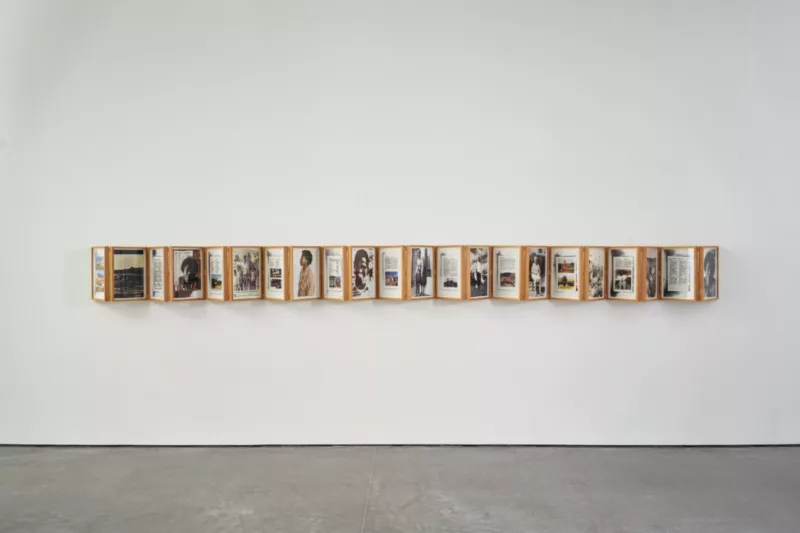
Williamson briefly explains in a conversation with Kganye, “Not that South Africa is in any way perfect today, but the difference between now and then is huge. Apartheid dictated which area you could live in, which school or university you could go to, which hospital would take you in an emergency, and which jobs were available to you.” Williamson responded to the ongoing crisis at the time by using her photography as an act of resistance. It is not mentioned in the exhibition that Williamson is a white South African and thus had much more freedom of expression during the Apartheid, as well as immeasurable other privileges and safeties than the people she is documenting. She documented individuals, families, and homes that were being murdered, displaced, or erased. The works I found most affecting were “The Last Supper at Manley Villa”(1981-2008) and “A Tale of Two Cradocks”(1994). In “The Last Supper…” she documented the last time the Ebrahim family would celebrate Eid in their house before it was demolished since the neighborhood was designated a white area, the family wrote and drew on the walls to leave their mark on their home. In “A Tale of…” Williamson altered a tourist booklet of a neighborhood in which apartheid activists who had been murdered had lived. The pamphlet was written as if the neighborhood had never existed. She inserted photographs, personal stories, and ephemera to place the activists and their neighborhoods into history.
This insertion into history mirrors prevalent themes in the work shown by Kganye. Photography and video is also a primary medium for her, she places herself backward in time, acting as her mother, grandfather, herself, and unknown ancestors. While Williamson displays memories, Kganye searches for them. She digs through her family’s stories, asking them questions, and receives tall family tales in return. She creates dioramas as stages for these tales. They were found in slapstick animation cut-outs of stories of her grandfather – jiggling and bouncing in the background. Also in delicately beautiful photo collages, flattened diorama stages made of the neighborhood street, and homes. In “In Search for Memory”(2020-22), visually we start to see the scene as a character approaching, rather than an audience watching. This is further emphasized in the piece “Mohlokomedi wa Tora”(2018) where the black and white collaged dioramas have now become incredibly large. The photographs are printed on large flats supported by 2x4s, giving the effect of the set of a stage play. In order to step into the room, the viewer must walk within these sets, surrounded by them, given no choice but to become an actor in the scene. As a Black South African, Kganye’s family narrative is irrevocably affected by Apartheid. Each of the four scenes is meant to represent four places the family had lived in temporarily as well as the four iterations of Kganye’s last name. Due to apartheid-era legislation, the family was displaced, quartering the name through documentation errors and other untraceable effects of the time. In another video, Kganye casts herself as a lightkeeper, tending to the lighthouse of her family’s narrative and heritage. It is mimicked by an oscillating spotlight in the center of “Mohlokomedi wa Tora”, each turn shining on one of the four names and places.
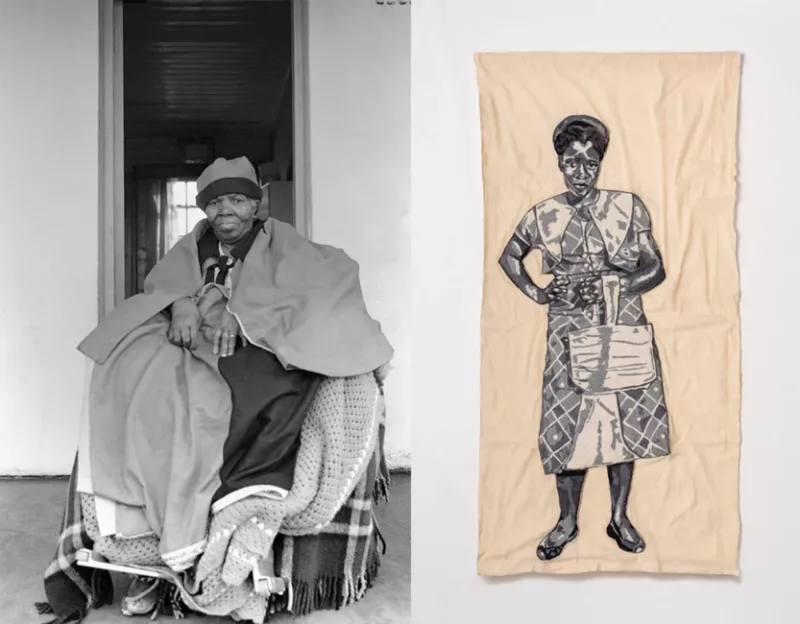
In the entrance to the gallery, Williamson has displayed work photographing many mothers in South Africa which flanks three large central pieces by Kganye. Kganye’s most recent and ongoing work “Mosebetsi wa Dirithi ” is dedicated to large gorgeous hand-stitched portraits made from tiny gray, white, and black pieces of fabric. These figures are her grandmother, mother, and cousin whom she only knew through stories. The tones mimic the black-and-white photography that Kganye uses almost exclusively in previous works. Now the figures have taken on a larger-than-life, textural quality. Their small collaged pieces create a subtle visual animation on the surface of the image – mimicking the videos also on display.
In the later half of Williamson’s work displayed, there is an emphasis on repair, and then an analysis of forgiveness. She begins to investigate the effects of the Truth and Reconciliation Commission (TRC) on older and younger generations. The TRC was an amnesty measure throughout the 90s in which the aim was to seek out and collect the truth of human rights violations that occurred during the Apartheid. Victims and perpetrators and those that were both gave testimony. TRC did have the power to grant amnesty to perpetrators who confessed, a portion of amnesty requests were granted based on the nature of the crimes, political motivation, and full disclosure and contrition. Williamson documents the intergenerational effects of the TRC in a series of video interviews called “No More Fairy Tales”(2016-2019). The older and younger generation of a family is interviewed side by side. One member of the “born free” generation states that the freedom they are purported to have is false and that the TRC robbed the country of anger needed to heal. She is in graduate school as the only Black student in her program and feels that segregation daily. Another interviewee when being asked if he feels forgiveness for crimes that happened to his family before he was born said, “I don’t forgive anyone, it’s not on me to forgive. I’m more softer and accepting of what is and what happened.”
In Kganye’s work, no such forgiveness is ever mentioned. While Williamson documents the effects of apartheid on families, Kganye takes a more artistic, somewhat fictive approach. Through this collection of materials, collaging together things that might have been, and were, stories passed down with smudged edges, the part of story and memory that cannot be expressed by language is communicated. This rings through as exceptional truth.
Tell Me What You Remember is an exhibit that is effective in displaying the thing that is missing when history is read from a textbook. Williamson’s work takes a more direct activist approach that sometimes verges on agitprop and memorial at others. For the exhibit to be successful I believe it needs the balance added by Kganye’s work, the personal, the ephemeral, the story that exists between words and beyond language. Kganye is quoted as saying, “I, therefore, cannot imagine that we would be able to make the kind of works we make, both those that are part of this exhibition and those that aren’t, if not for this turmoil and history that our work speaks to.” I overheard another visitor in the gallery ask a docent if Apartheid was still going on in South Africa. I was surprised but this kind of forgetfulness fit oddly within the perimeters of the exhibit. The exhibit is unmistakably placed in murky waters that exist between memory, truth, and history, and I appreciate how there is no conclusion placed on its questions. Can you forgive what you can’t remember? Should forgiveness be the goal at all?
Sue Williamson & Lebohang Kganye: Tell Me What You Remember was at the Barnes Foundation March 5 – May 21, 2023


